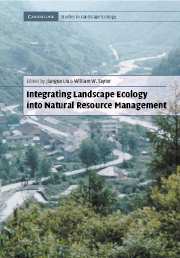Book contents
- Frontmatter
- Contents
- List of contributors
- Foreword
- Preface
- Acknowledgments
- PART I Introduction and concepts
- PART II Landscape structure and multi-scale management
- PART III Landscape function and cross-boundary management
- PART IV Landscape change and adaptive management
- PART V Landscape integrity and integrated management
- 14 Putting multiple use and sustained yield into a landscape context
- 15 Integrating landscape ecology into fisheries management: A rationale and practical considerations
- 16 Applications of advanced technologies in studying and managing grassland landscape integrity
- 17 An integrated approach to landscape science and management
- PART VI Syntheses and perspectives
- Index
- Plate Section
17 - An integrated approach to landscape science and management
Published online by Cambridge University Press: 14 January 2010
- Frontmatter
- Contents
- List of contributors
- Foreword
- Preface
- Acknowledgments
- PART I Introduction and concepts
- PART II Landscape structure and multi-scale management
- PART III Landscape function and cross-boundary management
- PART IV Landscape change and adaptive management
- PART V Landscape integrity and integrated management
- 14 Putting multiple use and sustained yield into a landscape context
- 15 Integrating landscape ecology into fisheries management: A rationale and practical considerations
- 16 Applications of advanced technologies in studying and managing grassland landscape integrity
- 17 An integrated approach to landscape science and management
- PART VI Syntheses and perspectives
- Index
- Plate Section
Summary
Introduction
Science is currently at a crossroads, and some hard decisions are needed about what needs to be achieved and how to achieve it. Classical reductionist methods, while successful up to a point, cannot adequately deal with complex broad-scale environmental questions. Similarly, the fragmentation of science into many disciplines has led to a fragmentary approach to these same questions. Finally, the separation of science from other types of human endeavor has led to an isolationist view which prevents the integration of scientific information with other types of knowledge.
Set against this problem is an increasing need for methods and options for managing and planning landscapes that are in various states of disrepair. The development of such options has to take account of not only the biophysical elements and all the complexity and interrelationships between these elements, but also the social and economic contexts, and all their inherent complexities and uncertainties. Options have to take the form, not of vague guiding principles, but of recommendations that can be applied in a quantitative way in any particular situation.
Thus there is a struggle between these apparently opposing needs – the need to include as much of the complexity and context as possible in our investigations versus the need to deliver simple quantitative options for what actions to take in any given situation. In this chapter, we present an example of an approach to developing landscape management and restoration options for biodiversity conservation which can be integrated with other management goals in a production landscape.
Information
- Type
- Chapter
- Information
- Integrating Landscape Ecology into Natural Resource Management , pp. 412 - 430Publisher: Cambridge University PressPrint publication year: 2002
Accessibility standard: Unknown
- 5
- Cited by
